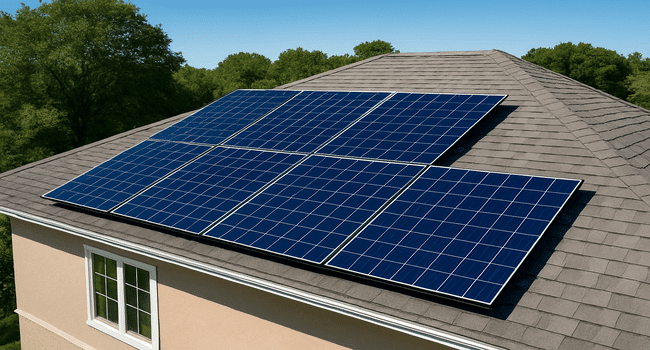Table of Contents
If you are considering changing to sun, you are not by myself. Many of you marvel if installing solar panels is a great concept. You may marvel how lengthy it’ll take before you start saving cash.
So let’s explore the prices you have to expect. Let’s also see the benefits you can get from solar panels.
What Do You Pay For? The Components and One-time Costs
A typical rooftop solar installation for a home includes several parts and labour. You will have to pay for:
- Solar modules. It is the solar panels themselves.
- Mounting structure and wiring.
- An inverter. You can use this to convert DC to AC.
- One or more batteries if you want storage.
- Installation and paperwork. It includes net-metering or local approvals.
- Optional: monitoring system and periodic maintenance.
The cost can change based on how big your system is in kilowatts and the quality of the parts you choose. It may also be higher if you decide to add battery storage.
What You Gain: The Benefits, Short and Long-term
Here is what you can get when you use solar panels:
- Lower energy bills: Solar power reduces your reliance at the grid. Any extra power your panels generate can regularly be despatched returned to the grid. This facilitates you earn credit via internet metering. Your financial savings depend on how a lot of your power needs the solar device covers.
- Energy independence and backup: Pairing solar panels with batteries continues critical appliances walking for the duration of electricity outages. It additionally shields you from fluctuations in grid energy fees.
- Predictable lengthy-time period expenses: Apart from minor upkeep, your foremost cost over time may be replacing the inverter, a key factor of your gadget. Overall, sun energy makes your energy fees extra predictable.
- Durability and warranties: Modern sun panels are robust. They are made to last. They use PID-resistant technology. It additionally comes with reliable product warranties.
Cost vs Benefit
Here is a comparison to help you see the differences:
| Factor | Typical cost/implication | Typical benefit |
| System (per kW) | Upfront purchase & installation (varies by region) | Reduced grid consumption; immediate bill savings |
| Battery add-on | Higher upfront cost | Backup power; higher self-consumption |
| Maintenance | Low (cleaning, occasional checks) | Long system life with minimal effort |
| Warranty | Often 10-12 years for modules (check product) | Gives you assurance on performance |
How To Estimate Payback and Savings?
Here is a practical worked example. You can get surprisingly close to an answer for your home with a few numbers:
- Find your average monthly electricity bill.
- Decide how much of that you want solar to cover (%).
- Use a local cost per kW installed to estimate system price.
- Use an estimate of annual generation to calculate how much grid energy you will give out. It can be kWh per kW installed.
Example:
- Your yearly electricity use. It may be three,six hundred kWh (three hundred kWh/month).
- You set up three kW of panels producing ~3,600 kWh/12 months. Like 1,two hundred kWh/kW/year assumed.
- You ought to shop around ₹28,800 every yr. That is, if your grid power charges ₹eight in line with kWh.
- If you put in a three kW system for ₹1,50,000, it is able to take about five to 6 years to pay for itself. This does no longer encompass any subsidies or inflation.
You can adjust the numbers based on your local rates and roof direction. Also, if there is any shading. It can help you to get a clearer idea.
Things That Change the Calculation
- Sunlight at your location: Your roof, tilt and shading matter.
- Component quality and warranty: You might pay a little extra at first if you choose panels with better quality and strong warranties. This also helps you avoid bigger problems and costs later.
- If you include batteries: Batteries improve your resilience. But it can add to the cost and can change the payback.
- Local incentives and net metering: Any subsidy or favourable export coverage shortens your payback period.
Maintenance and Lifespan
Solar systems are low maintenance compared with many household systems. Hers is what you need to do:
- Keep your solar panels reasonably clean. You can do a rinse or a gentle brush where dust can be.
- You should schedule a yearly check-up for your system’s mountings, wiring and inverter. You can do this to make sure everything is working well.
- Use a monitoring system so you notice production dips early.
Questions You Need to Ask Your Installer
When you request quotes, ask these practical questions:
- What panel model are you using and what are its datasheet specs?
- What is the anticipated annual generation I can get from the device?
- What warranties can I practice to the solar panels, inverter and workmanship?
- Will you get help with net-metering or documentation?
- If I want batteries later, can the system be upgraded easily?
Summing Up
For many of you, the benefits of solar panels can be worth the cost. It can lower bills and offer energy independence. It also helps the environment. Also, your system can pay for itself in just a few years. How much you get from solar panels depends on how much sun your panel gets. It also matters what your local electricity prices are. Adding a battery for your storage is also important. So, weighing these factors will help you decide on your solar panels. You can get to know what is right for your home.
Read more on KulFiy
